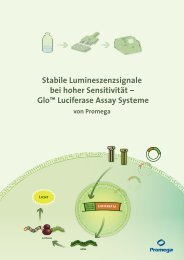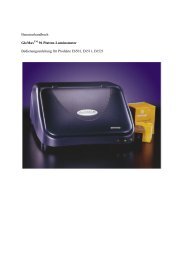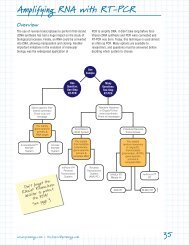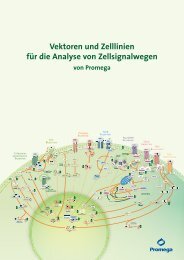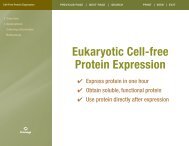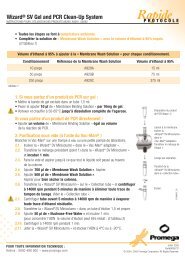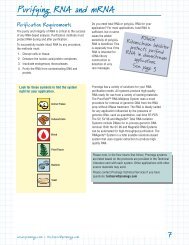The Role of Cell-Free Rabbit Reticulocyte Expression ... - Promega
The Role of Cell-Free Rabbit Reticulocyte Expression ... - Promega
The Role of Cell-Free Rabbit Reticulocyte Expression ... - Promega
Create successful ePaper yourself
Turn your PDF publications into a flip-book with our unique Google optimized e-Paper software.
Chapter<br />
<strong>The</strong> <strong>Role</strong> <strong>of</strong> <strong>Cell</strong>‑<strong>Free</strong> <strong>Rabbit</strong><br />
<strong>Reticulocyte</strong> <strong>Expression</strong> Systems<br />
in Functional Proteomics<br />
Michele Arduengo, Elaine Schenborn and Robin Hurst*<br />
Abstract<br />
In the broad area <strong>of</strong> functional proteomics, that is the global characterization <strong>of</strong> proteins and<br />
their function, cell‑free rabbit reticulocyte lysate (RRL) has been used extensively to elucidate<br />
the mechanisms <strong>of</strong> mammalian translation, cotranslational modifications, post‑translational<br />
modifications and translocation <strong>of</strong> proteins. More recently, RRL has been used as the workhorse<br />
for manufacturing the proteins engaged in interaction, selection and protein evolution studies<br />
from DNA or mRNA libraries either in microarray, display or in vitro expression cloning (IVEC)<br />
technologies. This chapter highlights recent functional proteomics applications that use cell‑free<br />
mammalian RRL.<br />
Abbreviations<br />
CMM, canine microsomal membrane; ER, endoplasmic reticulum; ERAD, endoplasmic<br />
reticulum‑associated degradation; GPI, glycosylphosphatidylinositol; IVC, in vitro compart‑<br />
mentalization; IVEC, in vitro expression cloning; PCR, polymerase chain reaction; PTT, protein<br />
truncation test; RRL, rabbit reticulocyte lysate; RT‑PCR, reverse transcription‑polymerase chain<br />
reaction; SP cells, semipermeabilized cells.<br />
HighWire Press is a registered trademark <strong>of</strong> Stanford University. TnT is a registered trademark<br />
<strong>of</strong> <strong>Promega</strong> Corporation.<br />
Introduction<br />
In late 1950s and early 1960s researchers first demonstrated that radioactive amino acids could<br />
be incorporated into hemoglobin in cell‑free rabbit reticulocyte lysate (RRL). 1,2 Since then RRL<br />
has been used to elucidate the highly complex events that encompass translation, from initiation<br />
to termination. 3‑5 RRL has also proven useful in understanding cotranslational folding <strong>of</strong> nascent<br />
polypeptide chains, protein targeting and post‑translational folding. During the 1970s, researchers<br />
showed that RRL could be manipulated for exogenously directed mRNA protein synthesis, so<br />
that only a single protein <strong>of</strong> interest was synthesized. 6 In the 1990s, the development <strong>of</strong> coupled<br />
transcription/translation, in which RRL is supplemented with T7, T3, or SP6 RNA polymerases<br />
further simplified the expression <strong>of</strong> protein targets. 7,8 DNA‑directed protein synthesis in RRL<br />
has some advantages over mRNA‑primed RRL including the elimination <strong>of</strong> mRNA handling,<br />
and it usually achieves higher levels <strong>of</strong> protein synthesis. An advantage <strong>of</strong> cell‑free RRL over<br />
other cell‑free systems (E. coli or wheat germ extracts) is that the mammalian environment more<br />
*Corresponding Author: �o�in �o�in �urst��ese�r�h �urst��ese�r�h �nd �nd �e�e�op�ent�� �e�e�op�ent�� �ro�eg� �ro�eg� Corpor�tion��<br />
Corpor�tion��<br />
2800 Woods �o��ow �d.�� M�dison�� WI�� USA 53711. ���i�: ���i�: ro�in.hurst�pro�eg�.�o�<br />
ro�in.hurst�pro�eg�.�o�<br />
ro�in.hurst�pro�eg�.�o�<br />
<strong>Cell</strong>-<strong>Free</strong> <strong>Expression</strong>, edited by Wieslaw Kudlicki, Federico Katzen and Robert Bennett.<br />
©2007 Landes Bioscience.
<strong>Cell</strong>-<strong>Free</strong> <strong>Expression</strong><br />
closely mimics human cells. <strong>Cell</strong>‑free RRL is generated from lysed reticulocytes isolated from<br />
phenylhydrazine‑treated rabbits. <strong>The</strong> lysed reticulocytes are treated with microccocal nuclease<br />
to remove endogenous mRNA. <strong>The</strong> RRL is optimized and supplemented with components that<br />
give optimal translation when priming with mRNA and, in the case <strong>of</strong> a coupled system, optimal<br />
translation/transcription for priming with DNA that contains the appropriate RNA phage poly‑<br />
merase promoter sequences.<br />
<strong>Cell</strong>‑free RRL has the same advantages as all cell‑free systems over cell‑based expression sys‑<br />
tems: substantial time‑savings (two hours versus 24–48 hours for protein expression), the ability<br />
to adapt to high‑throughput formats, increased tolerance to additives and less sensitivity to toxic<br />
or proteolytic proteins. <strong>The</strong> current use <strong>of</strong> cell‑free RRL is substantial as illustrated by a HighWire<br />
Press® search covering January 2000 to April 2006 that yielded more than 3,000 articles containing<br />
the phrase “rabbit reticulocyte.” This chapter will focus on recent applications that use RRL for<br />
cell‑free functional proteomics.<br />
Membrane Topology<br />
Synthesis <strong>of</strong> Membrane Proteins<br />
Membrane protein topology is <strong>of</strong>ten described based on the predicted amino acid sequence and<br />
algorithms that estimate hydrophobicity and probable secondary structure <strong>of</strong> a stretch <strong>of</strong> amino<br />
acids. 9 However, different algorithms or different stringencies applied to the same algorithm can<br />
predict different topologies, and many algorithms fail to account for cotranslational processing<br />
events or the effects <strong>of</strong> post‑translational modifications on protein topology. 9 Translation in a<br />
cell‑free system containing microsomes or semipermeabilized cells can provide empirical data<br />
about membrane protein topology.<br />
Using a prepared lysate supplemented with endoplasmic reticulum (ER)‑derived microsomal<br />
membranes such as canine pancreatic microsomal membranes (CMMs) 10‑12 or digitonin‑permea‑<br />
bilized cells (semipermeabilized cells), 13 membrane proteins can be successfully synthesized, trans‑<br />
located and modified in vitro. Semipermeabilized (SP) cells have some advantages over ER‑derived<br />
microsomes. SP cells are more likely to contain the necessary components for the correct folding<br />
and modification <strong>of</strong> proteins normally expressed by the cells, and they have a spatially intact ER<br />
and Golgi system that better approximates the cellular environment. 13 Additionally, SP cells can<br />
be more efficient at specialized modifications such as adding glycosylphosphatidylinositol (GPI)<br />
anchors. 14 Using SP cells and RRL without dithiothreitol allows disulfide bond formation and<br />
efficient folding <strong>of</strong> proteins such as MHC class I heavy chain. 15<br />
Proteins can be associated with the membrane in a variety <strong>of</strong> ways. Integral membrane proteins<br />
span both leaflets <strong>of</strong> the phospholipid bilayer with one or more alpha helical transmembrane do‑<br />
mains consisting <strong>of</strong> approximately 20 hydrophobic amino acids. Peripheral membrane proteins<br />
can be associated with a single membrane leaflet either by means <strong>of</strong> a fatty acid modification, such<br />
as prenylation, myristoylation, or a GPI anchor, or by association <strong>of</strong> a predominantly hydrophobic<br />
stretch <strong>of</strong> amino acids. <strong>Cell</strong>‑free translation systems such as RRL supplemented with microsomes<br />
or SP cells can provide information about how a particular protein associates with a membrane. For<br />
instance, treating isolated microsomes with sodium carbonate dissociates peripheral but not integral<br />
membrane proteins from microsomes or semipermeabilized cells. 16 Such treatment has been used<br />
to show that the glycoprotein GP4 produced by the equine arteritis virus is an integral membrane<br />
protein, while the GP3 protein, produced by the same virus, is membrane‑anchored. 17<br />
Protease Protection Assays<br />
Protease protection assays are <strong>of</strong>ten used to help determine membrane protein topology and<br />
orientation. Water‑soluble proteases cannot freely cross the lipid bilayer <strong>of</strong> microsomes, so segments<br />
<strong>of</strong> proteins that are in the lumen <strong>of</strong> the microsomes will not be subject to protease digestion unless<br />
the microsomes are first permeabilized. Assuming that the lumen <strong>of</strong> microsomes represents the
<strong>The</strong> <strong>Role</strong> <strong>of</strong> <strong>Cell</strong>-<strong>Free</strong> <strong>Rabbit</strong> <strong>Reticulocyte</strong> <strong>Expression</strong> Systems in Functional Proteomics<br />
lumen <strong>of</strong> the ER, the segments <strong>of</strong> proteins in the lumen <strong>of</strong> the microsomes become extracellular<br />
once a protein is inserted into the plasma membrane.<br />
Several studies have used protease protection assays to determine the topology <strong>of</strong> membrane<br />
proteins, including determining which <strong>of</strong> two proposed topologies is correct for cytochrome b 5. 18 In<br />
this study, failure <strong>of</strong> carboxypeptidase Y to remove C‑terminal labeled methionines <strong>of</strong> cytochrome<br />
b 5 suggests that the C‑terminus is inside the lumen <strong>of</strong> the ER and inaccessible to the protease. 18<br />
Often, the protease assay is performed on proteins translated in the presence <strong>of</strong> microsomes or<br />
SP cells. <strong>The</strong> microsomes are incubated with the protease with or without concomitant detergent<br />
solubilization, and protease fragments are compared between the solubilized or unsolubilized<br />
samples. Using a proteinase K protection assay <strong>of</strong> proteins translated in RRL supplemented with<br />
CMMs, Umigai et al 19 showed that the M2 domain <strong>of</strong> the K + channel Kir 2.1 is oriented with the<br />
C‑terminus toward the cytoplasm. A similar assay has been used to explore the effect <strong>of</strong> pathogenic<br />
mutations on the prion (PrP) protein. 14 In addition to determining topology <strong>of</strong> a particular protein,<br />
researchers can use protease assays to dissect the process <strong>of</strong> ER binding and translocation. 20<br />
Tagging Membrane Proteins to Determine Orientation<br />
Another strategy for determining membrane topology involves tagging a protein with an<br />
enzyme or epitope. Tagging is <strong>of</strong>ten used in conjunction with other studies such as glycosylation<br />
or protease assays to give a more complete picture <strong>of</strong> membrane topology. In one study, the<br />
C‑terminal end <strong>of</strong> each <strong>of</strong> several deletion mutants <strong>of</strong> Presenilin I was tagged with E. coli leader<br />
peptidase (LPase). Anti‑LPase antibody was able to immunoprecipitate in vitro translated protein<br />
from some but not all <strong>of</strong> the deletion mutants based on the location <strong>of</strong> the C‑terminus <strong>of</strong> the<br />
protein (either cytosolic or luminal). 21 C‑terminal and N‑terminal glycosylation tags have also<br />
been used in experiments to investigate the topology <strong>of</strong> vitamin K epoxide reductase. 22<br />
Glycosylation<br />
N‑Linked Glycosylation <strong>of</strong> Membrane and Secreted Proteins<br />
Glycosylation studies in RRL supplemented with CMMs or SP cells can provide information<br />
about membrane topology. Portions <strong>of</strong> proteins translocated into the lumen <strong>of</strong> microsomes or<br />
SP cells are exposed to enzymes responsible for core N‑linked glycosylation. N‑linked glyco‑<br />
sylation acceptor sites can be inserted into the protein, at the N‑ or C‑terminus, for example.<br />
Any sugar residues that are added should be removed by the actions <strong>of</strong> glycosidases, such as<br />
endoglycosidase H, when microsomes containing the proteins are treated with detergents to<br />
allow the glycosidase access to the luminal portion <strong>of</strong> the protein. Such a strategy was used to<br />
determine the membrane topology <strong>of</strong> vitamin K epoxide reductase. 22 Zhang and Ling used sensi‑<br />
tivity to peptide N‑glycosidase (PNGaseF) to determine whether an 18 kDa protease‑protected<br />
fragment from mouse P‑glycoprotein is glycosylated. 23 Additionally, carrying out translation<br />
in RRL supplemented with microsomes in the presence or absence <strong>of</strong> tunicamycin (a glycosyl‑<br />
ation inhibitor) can allow comparison <strong>of</strong> glycosylated and unglycosylated forms <strong>of</strong> proteins<br />
produced in vitro. 24<br />
<strong>The</strong> membrane topology <strong>of</strong> polytopic proteins (proteins that span the membrane multiple<br />
times) can be especially difficult to predict. <strong>The</strong> Presenilin‑1 protein is a polytopic protein pre‑<br />
dicted by hydrophobicity analysis to span the membrane from six to eight times. To determine<br />
membrane topology for Presenilin‑1, a series <strong>of</strong> C‑terminal deletions was made to remove predicted<br />
transmembrane regions <strong>of</strong> the protein. <strong>The</strong> truncated proteins were translated in vitro in the<br />
presence <strong>of</strong> microsomes. Endoglycosidase H sensitivity <strong>of</strong> protein from solubilized microsomes<br />
changed as deletions <strong>of</strong> the transmembrane domains altered the orientation <strong>of</strong> the protein in the<br />
membrane. 21 Combined with protease protection assays and epitope tag labeling at the C‑terminus,<br />
these glycosylation results supported a seven‑transmembrane domain structure with an additional<br />
membrane‑embedded domain for Presenilin‑1.
<strong>Cell</strong>-<strong>Free</strong> <strong>Expression</strong><br />
O‑linked Glycosylation <strong>of</strong> Cytosolic and Nuclear Proteins<br />
Secretory and membrane proteins are not the only proteins in the cell that are glycosylated.<br />
Many nuclear and cytosolic proteins are modified by O‑linked glycosylation (O‑GlcNAcylation). 25<br />
RRL contains the enzymes and substrates necessary for the O‑GlcNAcylation <strong>of</strong> proteins, 26 and<br />
addition <strong>of</strong> microsomes or SP cells provides the environment necessary for correct membrane‑<br />
protein folding. To assess whether the insulin‑responsive glucose transporter GLUT4 undergoes<br />
O‑GlcNAcylation, GLUT4 cDNA was transcribed and translated in RRL supplemented with<br />
CMMs. 25 RRL was able to successfully modify GLUT4 protein. 25<br />
Lipid Modification and Acetylation <strong>of</strong> Proteins<br />
Glycosylphosphatidyl Inositol (GPI) Anchors<br />
Some proteins are anchored to the cell membrane by means <strong>of</strong> a glycosylphosphatidyl inositol<br />
(GPI) modification at the C‑terminus. 27 Unlike proteins incorporated into the membrane by a<br />
transmembrane domain, proteins that are GPI‑anchored are reversibly associated with the lipid<br />
bilayer. GPI anchoring does not appear to be necessary for cell survival, but it is necessary for<br />
development. 28 Proteins that are modified by the addition <strong>of</strong> a GPI anchor contain two signal<br />
sequences, one at the N‑terminus that directs protein synthesis to the ER and a second at the<br />
C‑terminus that directs the addition <strong>of</strong> the GPI‑anchor by a transamidase activity. 29 Small nucleo‑<br />
philic compounds like hydrazine can substitute for GPI, providing a means to assess whether GPI<br />
modification has occurred by comparing the molecular weight <strong>of</strong> proteins translated in the presence<br />
or absence <strong>of</strong> hydrazine. 30 Human placental alkaline phosphatase (PLAP) is a GPI‑anchored pro‑<br />
tein. 24 GPI‑anchored mini‑PLAP has been generated by numerous groups using nuclease‑treated<br />
RRL supplemented with microsomal membranes from CHO, F9, EL4 or K562 cells, 24,28,29,31‑33<br />
demonstrating that GPI modification can be reconstituted in a cell‑free system.<br />
Prenylation<br />
Some proteins are modified by prenylation, the attachment <strong>of</strong> one or more isoprenoid groups,<br />
such as the 15‑carbon farnesyl group or the 20‑carbon geranylgeranyl group, to a cysteine residue.<br />
Prenylation can mediate membrane association <strong>of</strong> some proteins, particularly the Ras‑like GTPases,<br />
and protein‑protein interactions (e.g., nuclear lamins). 34 Prenylated proteins can be produced<br />
and detected in RRL supplemented with the labeled isoprenoid precursor mevalonic acid after<br />
the translation reaction is complete; additionally proteins synthesized in RRL can be modified<br />
using photoactivatable analogs <strong>of</strong> isoprenoids. 35‑37 Gel‑based assays to detect changes in protein<br />
migration as a result <strong>of</strong> prenylation are also used, but these are indirect assays and are usually<br />
performed along with a labeling experiment. Most prenylation assays require autoradiography<br />
<strong>of</strong> the labeled lysate, which can take weeks or months. Benetka and colleagues have developed<br />
an in vitro prenylation assay using N‑terminal GST‑tagged proteins and detection <strong>of</strong> 3 H‑labeled<br />
precursors using a TLC linear analyzer. 38 <strong>The</strong> incorporation <strong>of</strong> the GST tag allows the labeled<br />
protein <strong>of</strong> interest to be separated from free radioactive label and other proteins in the RRL, and<br />
using the TLC scanner to detect the incorporated lipid molecule significantly reduces the time<br />
required to obtain results.<br />
N‑Myristoylation and Palmitoylation<br />
Many proteins in eukaryotic cells are subject to N‑myristoylation, the addition <strong>of</strong> a 14‑<br />
carbon fatty acid to the N‑terminus. 39 In addition to being prenylated, the alpha subunits <strong>of</strong><br />
some G‑proteins, including pp60 src and p21 ras , are myristoylated. Other G‑protein alpha subunits,<br />
including some <strong>of</strong> the G s and G q subunits, are not myristoylated, but are instead modified by the<br />
attachment <strong>of</strong> a 16‑carbon palmitic acid (palmitoylation), and others are both myristoylated and<br />
palmitoylated. Some studies suggest that N‑myristolyation and palmitoylation contribute to the<br />
membrane association <strong>of</strong> these proteins. 40‑42 N‑myristoylation can occur cotranslationally, imme‑<br />
diately after the removal <strong>of</strong> the N‑terminal methionine from a protein or even post‑translationally<br />
as with the protein BID (BCL‑2 interacting domain), a substrate <strong>of</strong> caspase‑8. 39,43 Upon cleavage
<strong>The</strong> <strong>Role</strong> <strong>of</strong> <strong>Cell</strong>-<strong>Free</strong> <strong>Rabbit</strong> <strong>Reticulocyte</strong> <strong>Expression</strong> Systems in Functional Proteomics<br />
by caspase‑8, BID reveals an N‑myristoylation site. RRL contains the components necessary<br />
to complete N‑myristoylation, and has even been used to myristoylate tumor necrosis factor, a<br />
normally nonmyristoylated protein, when it is modified to contain the N‑myristolyation motif<br />
<strong>of</strong> other myristoylated proteins. 44,45 <strong>The</strong> Arabidopsis SOS3 protein involved in plant salt tolerance<br />
has also been synthesized and myristoylated in an RRL system. 46<br />
N‑Acetylation<br />
A majority (70–85%) <strong>of</strong> the proteins found in the cytoplasm or nucleus <strong>of</strong> eukaryotes may be<br />
modified by N‑acetylation. 47,48 Examples <strong>of</strong> N‑acetylated proteins include ovalbumin, actin and<br />
cytochrome c. Acetylation is catalyzed by N‑acetyltransferases cotranslationally after the initiator<br />
methionine has been cleaved. 48 Many proteins are also acetylated post‑translationally at internal<br />
sites by acetyltransferase enzymes different from those involved in cotranslational modification. 48<br />
Acetylation <strong>of</strong> modified tumor necrosis factor (TNF) has been demonstrated in RRL, 47 and acety‑<br />
lation in RRL can be inhibited by the use <strong>of</strong> S‑acetonyl‑CoA, an analog <strong>of</strong> acetyl‑CoA. 49<br />
Reconstituting ER‑Associated Protein Degradation<br />
Conditions such as environmental stress, viral infection and the absence <strong>of</strong> required partner<br />
proteins can result in the accumulation <strong>of</strong> aberrantly folded proteins in the rough endoplasmic<br />
reticulum (RER). <strong>The</strong> RER has a “quality control” system that targets these misfolded proteins<br />
for degradation. This process, ER‑Associated Degradation (ERAD), requires ATP and is distinct<br />
from the lysosomal degradation pathway in cells. 50<br />
RRL in conjunction with CMMs or SP cells has been used to reconstitute ERAD activity.<br />
RRL has several advantages over intact‑cell systems for such study. <strong>The</strong> protein <strong>of</strong> interest will be<br />
the only protein labeled in the RRL, making its degradation easy to follow. 51 Second, a variety<br />
<strong>of</strong> microsomal membranes can be used with RRL to reconstitute the activity. 15,51 Because hemin<br />
inhibits the proteasome activity <strong>of</strong> ERAD, degradation studies are best performed in RRL that<br />
does not contain exogenous hemin. Researchers have reported that RRL that works well for studies<br />
<strong>of</strong> degradation is usually poor for translation. 51 Additionally, since ERAD is ATP‑dependent, the<br />
RRL will need to be supplemented with ATP and an ATP regeneration system, 51 and some authors<br />
report that excess unlabeled methionine seems to aid in reconstituting ERAD activity. 52<br />
RRL‑based protein degradation systems have been used to investigate the synthesis, stability<br />
and degradation <strong>of</strong> a variety <strong>of</strong> wild type and mutant proteins. In one such study, tyrosinase<br />
ERAD was reconstituted in a commercially available RRL system supplemented with an ATP<br />
regeneration system. 53 Wild type and mutant tyrosinase associated with albinism were translated<br />
in the presence <strong>of</strong> SP melanocytes; the SP cells were isolated and then resuspended in RRL<br />
with the ATP regeneration system. Both proteins were degraded, although the mutant protein<br />
degraded at a higher rate than the wild type protein. RRL‑based and rat cytosol‑based degra‑<br />
dation systems have also been used to investigate the degradation <strong>of</strong> Apoprotein B (apoB). 54<br />
Aliquots <strong>of</strong> the transcription/translation reaction <strong>of</strong> HA‑tagged apoB were incubated in the<br />
presence <strong>of</strong> an ATP regeneration system in fresh RRL or rat hepatocyte cytosol with or without<br />
proteasome inhibitors. Inhibition <strong>of</strong> apoB degradation was more obvious in the rat hepatocyte<br />
cytosol, presumably because RRL contains factors that interfere with the proteasome inhibitors.<br />
To assess the role <strong>of</strong> the chaperone protein, hsp90, in the degradation <strong>of</strong> apoB48, geldanamycin<br />
(GA), an antibiotic that competes for the ATP binding site on hsp90, was added to pelleted<br />
CMMs before the degradation assay. <strong>The</strong>re was no significant decrease in the amount <strong>of</strong> apoB48<br />
in the presence <strong>of</strong> GA, indicating that GA did inhibit degradation and hsp90 was required for<br />
apoB48 degradation. 54<br />
RRL has been used to reconstitute the degradation <strong>of</strong> α 1‑antitrypsin Z [(α 1AT)Z]. 52 Individuals<br />
who are homozygous recessive for a mutation resulting in a Glu 342 to Lys substitution have increased<br />
susceptibility to liver disease. 52 <strong>The</strong> amino acid substitution disrupts proper folding <strong>of</strong> (α 1AT)Z,<br />
and individuals susceptible to the liver disease are not able to degrade the misfolded protein effi‑<br />
ciently. Mutant and wild type (α 1AT)Z degradation were examined using an RRL degradation assay<br />
system. <strong>The</strong> mutant (α 1AT)Z was degraded efficiently. Mutant protein produced in the presence<br />
15, 51
<strong>Cell</strong>-<strong>Free</strong> <strong>Expression</strong><br />
<strong>of</strong> salt‑washed or puromycin‑treated, salt‑washed microsomes was also degraded, indicating that<br />
the full complement <strong>of</strong> RER proteins was not required for degradation. 52<br />
Several mechanisms have been suggested to control the targeting <strong>of</strong> proteins accumulated in<br />
the ER for degradation, including regulating the trimming <strong>of</strong> N‑linked oligosaccharide chains.<br />
Oligosaccharide side chains can be modified by mannosidase I in the ER. Inhibiting this activity<br />
seems to stabilize misfolded proteins. 15 Wild type MHC class I heavy chain and a mutant heavy<br />
chain that lacks the N‑linked glycosylation site but that can assemble into functional MHC class I<br />
molecules were translated in RRL in the presence <strong>of</strong> SP HT1080 cells. 15 <strong>The</strong> wild type protein was<br />
degraded more quickly than the mutant, indicating that glycosylation is important for ERAD.<br />
In Vitro Viral Assembly<br />
<strong>The</strong> ability to reconstitute cotranslational assembly events and protein interactions using<br />
cell‑free RRL systems can be extended to the study <strong>of</strong> in vitro mammalian viral protein assembly,<br />
viral protein interactions with other cellular components, and viral protein effects on translation.<br />
Early studies <strong>of</strong> viral protein assembly demonstrated that capsid proteins expressed in RRL were<br />
capable <strong>of</strong> self‑assembling in vitro. For example, adenovirus type 2 fiber protein synthesized in<br />
RRL formed trimers without requiring additional viral proteins or components. 55 From this<br />
relatively well‑defined, single‑protein model, more complex viral protein interactions and as‑<br />
sembly studies evolved. Human papillomavirus‑like particles have been assembled in vitro from<br />
L1 capsid protein expression in RRL. 56 <strong>The</strong>se particles also mimicked endogenous virus in its<br />
conformational epitope exposure, and antibodies generated against the in vitro‑assembled L1<br />
particles were effective in recognizing similar epitopes in patient samples. In addition to human<br />
papillomavirus, human hepatitis C (HCV) core viral capsid precursor structures were also gen‑<br />
erated de novo in reticulocyte lysates. 57 <strong>Cell</strong>‑free systems have allowed detailed examination <strong>of</strong><br />
HCV core capsid assembly processes and properties, whereas mammalian culture systems have<br />
been limited by low viral titers.<br />
In vitro expression <strong>of</strong> Gag precursor proteins in RRL has allowed detailed examination <strong>of</strong> the<br />
more complex pathway for retroviral assembly, which includes not only protein interactions, but<br />
also plasma membrane interactions and budding. Viral capsid structures <strong>of</strong> immunodeficiency<br />
virus type 1 (HIV‑1) have been assembled from the Gag precursor protein p55 gag expressed in<br />
RRL, and these particles resembled immature HIV‑1 viral structures. 58 Additional processing <strong>of</strong><br />
proteins in viral capsids can include prenylation and glycosylation. Myristoylation <strong>of</strong> HIV‑1 viral<br />
particles 59 and glycosylation <strong>of</strong> woodchuck hepatitis virus capsid proteins 60 have been investigated<br />
using cell‑free RRL systems. <strong>The</strong>se results illustrate the importance <strong>of</strong> cell‑free protein expression<br />
in delineating processes involved in viral particle assembly pathways.<br />
Protein Microarray Technology<br />
In the field <strong>of</strong> functional proteomics, protein microarrays are filling a niche for miniaturization<br />
coupled with high‑throughput assay capability. 61,62 Protein microarray concepts are patterned after<br />
DNA microarrays, but immobilization <strong>of</strong> diverse types <strong>of</strong> proteins in a manner that preserves con‑<br />
formation and functionality is a complex and challenging problem to solve. Continuing advances<br />
in microarray surface chemistries coupled with improvements in protein production capabilities,<br />
sensitive detection methods, and instrumentation are accelerating the pace <strong>of</strong> development for<br />
protein microarrays. Microarray formats include printing proteins at high density on a glass slides<br />
or other solid surfaces, using miniaturized reaction chambers adapted for slides, and assaying<br />
samples in multiwell plates.<br />
Currently two general types <strong>of</strong> protein microarray applications are being pursued: antibody‑ or<br />
peptide‑based arrays and functional protein arrays. Antibody‑ or peptide‑based arrays bind pro‑<br />
teins <strong>of</strong> interest in given samples, such as serum, and can provide information about the amount<br />
and specificity for binding <strong>of</strong> such proteins. This is referred to as protein pr<strong>of</strong>iling. <strong>The</strong> search<br />
for disease biomarkers for diagnostic purposes and drug screening capabilities drives many <strong>of</strong><br />
the innovations for these types <strong>of</strong> arrays. Another strategy is to use protein microarray formats
<strong>The</strong> <strong>Role</strong> <strong>of</strong> <strong>Cell</strong>-<strong>Free</strong> <strong>Rabbit</strong> <strong>Reticulocyte</strong> <strong>Expression</strong> Systems in Functional Proteomics<br />
Figure 1. S�he��ti� <strong>of</strong> �u�tiwe�� for��t protein �rr�y experi�ent. T�gged proteins �re gener�ted<br />
through �oup�ed tr�ns��tion �nd then �ind to �o�ted �u�tiwe�� surf��e. �rinted with<br />
per�ission fro� �ro�eg� Corpor�tion.<br />
to interrogate and carefully perturb protein functions such as protein‑protein, protein‑nucleic<br />
acid or protein‑small molecule interactions, as well as protein enzyme activities. <strong>Cell</strong>‑free protein<br />
expression systems, such as RRL, are well suited to supply the functional proteins required for<br />
these types <strong>of</strong> protein microarrays. <strong>Cell</strong>‑free protein expression in RRL is versatile and allows<br />
incorporation <strong>of</strong> specific moieties into the protein sequence for immobilization or detection<br />
strategies, as well as post‑translational modifications, in an automatable manner.<br />
Early pro<strong>of</strong>‑<strong>of</strong>‑principle for use <strong>of</strong> RRL in combination with a multiwell array‑type format was<br />
demonstrated by He and Taussig in 2001, 63,64 and named “PISA” (Protein In Situ Array). Proteins<br />
with double (His)6 tags were expressed directly from DNA templates with RRL in each well, and<br />
the expressed proteins were immobilized by the (His)6 tag to nickel‑coated surfaces. <strong>Expression</strong><br />
and immobilization <strong>of</strong> functional proteins were demonstrated by enzymatic activity <strong>of</strong> a cloned<br />
(His)6 tagged‑luciferase and a tagged‑single chain antibody fusion that bound its corresponding<br />
antigen, progesterone. Microwells <strong>of</strong>fer an advantage <strong>of</strong> maintaining aqueous reaction conditions<br />
that are compatible with native protein conformation, compared to more harsh conditions pres‑<br />
ent on a spotted glass slide. <strong>Expression</strong> <strong>of</strong> tagged protein expressed in cell‑free extracts eliminates<br />
laborious protein purification schemes (Fig. 1).
<strong>Cell</strong>-<strong>Free</strong> <strong>Expression</strong><br />
Oleinikov et al 65 describe a variation on protein arrays based on expression <strong>of</strong> protein from<br />
RRL with concomitant immobilization. This strategy exploits features <strong>of</strong> electronic semicon‑<br />
ductor microchips for protein binding and detection. A second variation <strong>of</strong> protein arrays takes<br />
advantage <strong>of</strong> the stability <strong>of</strong> immobilized DNA in microarrays, protein expression and spatially<br />
defined protein capture. 66 This approach, named NAPPA (nucleic acid programmable protein<br />
array) involves generating protein in situ with a coupled transcription/translation RRL layered<br />
onto slides printed with a mixture <strong>of</strong> biotinylated DNA, avidin and polyclonal GST antibody.<br />
Target proteins are expressed from template DNA encoding a C‑terminal GST fusion tag and<br />
then the fusion proteins are spatially bound to the GST antibody. <strong>The</strong> target proteins are detected<br />
using a monoclonal antibody to GST.<br />
Protein Interaction with Other Molecules<br />
<strong>Cell</strong>‑free RRL has been used to examine numerous protein‑protein, 70 protein‑DNA, 71,72 and<br />
protein‑RNA interactions 73‑75 via immunoprecitation 67,74‑76 and tagged protein pull‑down. 68,70,72<br />
Confirmation <strong>of</strong> protein‑protein interactions in vitro <strong>of</strong>ten includes expression <strong>of</strong> target proteins<br />
in RRL and pull‑down with a tagged protein, such as GST‑tagged protein, which is bound to<br />
a solid support. <strong>The</strong>se types <strong>of</strong> GST‑pull‑down experiments have been used to confirm spe‑<br />
cific interactions <strong>of</strong> protein involved in signal transduction, 77,78 transcription regulation, 79‑81 ion<br />
channels 82 and splicesosomes. 83 Reconstitution studies can be performed in which expressed pro‑<br />
teins form a complex in cell‑free RRL and give a measurable biochemical response that mimics<br />
an in vivo response. One interesting recent example is the demonstration that p43, a telomerase<br />
accessory protein, can affect the in vitro nucleotide addition activity and processivity <strong>of</strong> the con‑<br />
served core consisting <strong>of</strong> the protein telomerase reverse transcriptase (TERT) and the telomerase<br />
RNA subunit. <strong>The</strong> resulting reconstituted ternary complex [TERT•RNA•p43] was identified and<br />
examined by immunoprecipitation in coupled transcription/translation in RRL. 76<br />
Another interesting example <strong>of</strong> protein‑RNA interaction in RRL involved the depletion<br />
<strong>of</strong> the internal ribosome entry site (IRES)‑interacting protein <strong>of</strong> the RRL by the immobilized<br />
foot‑and‑mouth virus (FMDV)‑IRES. 84 <strong>The</strong> effect <strong>of</strong> the depleted lysate was assessed by transla‑<br />
tion efficiency <strong>of</strong> transcripts that were either capped or had FMDV IRES in the sense or antisense<br />
orientation. This procedure should be useful for analysis <strong>of</strong> protein‑RNA interactions and their<br />
role in IRES‑dependent translation.<br />
<strong>Cell</strong>‑free translations in RRL can also provide information about protein‑protein interactions.<br />
Translation in RRL with microsomal membranes and immunoprecipitations have helped to<br />
elucidate the mechanism <strong>of</strong> activation <strong>of</strong> the endogenous p21‑activated kinase 2 (PAK‑2) by Nef<br />
proteins that are encoded by human immunodeficiency virus (HIV) and simian immunodeficiency<br />
virus (SIV) in vitro. 67 <strong>The</strong> cell‑free system allows further investigation <strong>of</strong> the molecular mechanism<br />
<strong>of</strong> activation because the timing and order <strong>of</strong> component additions can be easily controlled.<br />
Protein interactions that involve ribosome‑associated chaperones (cotranslational folding<br />
and targeting) and post‑translational interactions have also been explored using RRL. 68‑70 During<br />
cotranslational folding the nascent chains interact with chaperones such as the 70‑kD heat shock<br />
protein cognate (Hsc‑70) and nascent polypeptide‑associated complex (NAC) 68,85 and chapero‑<br />
nins such as the Tailless complex polypeptide 1 (TCP1) ring complex (TRiC). 61,87 Recently the<br />
interaction <strong>of</strong> the TRiC with the nascent polypeptide chain as it emerges from the ribosome was<br />
demonstrated using photoreactive N ε ‑(5‑azido‑2‑nitrobenzoyl)‑Lys‑tRNA lys along with translation<br />
<strong>of</strong> truncated actin in the RRL. Post‑translation interactions <strong>of</strong> chaperones have been investigated<br />
using mutagenesis and immunoprecipitation from RRL after the expression <strong>of</strong> protein kinases.<br />
<strong>The</strong>se studies showed that phosphorylation <strong>of</strong> Ser 12 <strong>of</strong> the Hsp‑90 cochaperone Cdc37 is critical<br />
for its interaction with eukaryotic protein kinases and Hsp‑90. 70<br />
Historically, protein‑DNA interactions have been identified via mobility shift assays 71,72 in<br />
which the DNA binding activity <strong>of</strong> proteins expressed in RRL are visualized by a shift <strong>of</strong> molecular<br />
weight on native polyacrylamide gels. Human biliverdin reductase (hBVR) is a serine/threonine<br />
kinase that catalyzes the reduction <strong>of</strong> biliverdin to bilirubin in response to oxidative stress. Using
<strong>The</strong> <strong>Role</strong> <strong>of</strong> <strong>Cell</strong>-<strong>Free</strong> <strong>Rabbit</strong> <strong>Reticulocyte</strong> <strong>Expression</strong> Systems in Functional Proteomics<br />
hBVR and hBVR mutants that were translated in RRL and analyzed using a mobility shift assay,<br />
hBVR was found to bind to specific DNA sequences. 71<br />
Display Technologies<br />
<strong>Cell</strong>‑free display technologies, such as ribosome display, 86‑91 mRNA display 92‑94 or in vitro virus<br />
(IVV), 95 and in vitro compartmentalization (IVC) 96 are powerful technologies that can be used<br />
to identify protein‑target molecule interactions and for directed evolution <strong>of</strong> proteins for desired<br />
improvements. <strong>The</strong>se technologies rely on coupled transcription/translation or translation using<br />
RRL or other sources <strong>of</strong> lysates. <strong>Cell</strong>‑free display technologies have advantages over cell‑based<br />
display technologies such as phage display, 97 and cell surface display on bacteria 98 or yeast. 99 <strong>The</strong><br />
cell‑based display systems have limited library diversity because <strong>of</strong> transfection inefficiencies, the<br />
inability to specify incorporation <strong>of</strong> nonnatural amino acids via amber suppressor tRNAs and bias<br />
against cytotoxic proteins. Display technologies rely on coupling genotype (mRNA) to phenotype<br />
(protein) to retrieve the genetic information along with protein function.<br />
Eukaryotic Ribosome Display<br />
Eukaryotic ribosome display is an entirely cell‑free technology that screens and selects<br />
functional proteins and peptides from large libraries. For ribosome display, the link between<br />
genotype and phenotype is accomplished by an mRNA‑ribosome‑protein (PRM) complex that<br />
is stable under controlled conditions. <strong>The</strong> eukaryotic method <strong>of</strong> ribosome display using RRL for<br />
coupled transcription/translation has been used to display single‑chain antibodies to form an<br />
antibody‑ribosome‑mRNA (ARM) complex. 87,88,91 <strong>The</strong> function <strong>of</strong> the single‑chain antibody is<br />
evaluated by its binding properties to an immobilized antigen. <strong>The</strong> function <strong>of</strong> other non‑antibody<br />
proteins can be evaluated by using a different immobilized target, such as a partner protein, ligand<br />
or substrate, to capture the relevant PRM complexes. <strong>The</strong> mRNA that is complexed with the<br />
protein can then be amplified by reverse transcription polymerase chain reaction (RT‑PCR) and<br />
recovered as DNA. If screening and selection is the goal, then pro<strong>of</strong>reading DNA polymerases<br />
are necessary; however, if evolution or diversification <strong>of</strong> the DNA sequence pool is required, then<br />
a nonpro<strong>of</strong>reading polymerase such as Taq DNA polymerase is used. <strong>The</strong> major distinguishing<br />
feature between eukaryotic ribosome display and prokaryotic ribosome display 86,90 is that in<br />
eukaryotic ribosome display, the RT‑PCR is carried out on the intact PRM complexes rather than<br />
on mRNA that has been released from PRM complex.<br />
Eukaryotic ribosome display has been used to select the enzyme, sialyltransferase II, from<br />
a cDNA library in a 96‑well plate coated with the substrate, ganglioside GM3. 100 Coupled<br />
transcription/translation in an RRL expression system from the cDNA library resulted in an<br />
enzyme‑specific protein‑ribosome‑mRNA (PRIME) complex. A recently described modification<br />
<strong>of</strong> eukaryotic ribosome display incorporates Qβ RNA‑dependent RNA polymerase into the display<br />
and selection process. 101 This allows a continuous in vitro evolution (Fig. 2). <strong>The</strong> cell‑free RRL<br />
is used in the coupled transcription/translation mode to generate mRNA and then protein. <strong>The</strong><br />
Qβ RNA‑dependent RNA polymerase mutates the generated mRNA and thus the simultaneous<br />
display <strong>of</strong> the protein generated from the original mRNA. <strong>The</strong> ribosome ternary complexes display<br />
the synthesized proteins/single chain antibodies and are selected against immobilized antigens.<br />
For the selection process, the displayed wild type and mutants are competing for the target. <strong>The</strong><br />
recovery <strong>of</strong> the mRNA is the same as in ARM display.<br />
Recently, improvements have been developed for eukaryotic ribosome display that allow<br />
20.8‑fold more efficient selection 102 than current methods, making ribosome display a readily<br />
accessible technique for all researchers.<br />
mRNA Display or in Vitro Virus<br />
A different approach to the selection and identification <strong>of</strong> functional proteins is mRNA dis‑<br />
play, also called in vitro virus, 95 a technique that uses the cell‑free RRL translation system to link<br />
a peptide or protein covalently to its encoding mRNA. 92‑94 <strong>The</strong> mRNA has a puromycin‑tagged<br />
DNA linker ligated or photo‑crosslinked to the 3´‑terminus. 103 <strong>The</strong> ribosome will stall when
10 <strong>Cell</strong>-<strong>Free</strong> <strong>Expression</strong><br />
Figure 2. <strong>The</strong> proposed �ontinuous in �itro e�o�ution (CIV�) �y��e. <strong>The</strong> �oup�ed tr�ns�ription/tr�ns-<br />
��tion syste� with in��usion <strong>of</strong> Qβ rep�i��se. This produ�es � pro�ess in whi�h�� in the re��tion<br />
�ix�� ��NAs �re tr�ns�ri�ed fro� the �NA te�p��te �y T7 po�y�er�se�� rep�i��ted �nd �ut�ted<br />
�y the Qβ rep�i��se�� tr�ns��ted �nd disp��yed on the surf��e <strong>of</strong> the ri�oso�es. In se�e�ting �g�inst<br />
� t�rget�� the disp��yed wi�d type �nd �ut�nt �re �o�peting for the t�rget. �eprinted fro�: Ir�ing<br />
�A et ���� J I��uno� Meth 248:31-45; ©2001 with per�ission fro� ��se�ier. 101<br />
it reaches the mRNA‑DNA junction, and puromycin enters the ribosomal A‑site. <strong>The</strong> nascent<br />
peptide is coupled to the puromycin by the peptidyl‑transferase. <strong>The</strong> complex <strong>of</strong> peptide‑<br />
puromycin‑DNA linker‑mRNA is dissociated from the ribosome and can then be used for selec‑<br />
tion and identification <strong>of</strong> functional protein (Fig. 3). mRNA display or IVV in combination with<br />
in vitro selection are powerful tools for evolving and discovering new functional proteins. mRNA<br />
display <strong>of</strong> a random peptide library has been used to determine the epitope‑like consensus motifs<br />
that define the determinants for binding <strong>of</strong> the anti‑c‑Myc antibody. 104 Recently, a method has<br />
been described for mRNA display using a unidirectional nested deletion library. 105 <strong>The</strong> method<br />
identified high‑affinity, epitope‑like peptides for an anti‑polyhistidine monoclonal antibody and<br />
should be useful for determining minimal binding domains and novel protein‑protein interactions.<br />
Also, mRNA display can be used to select mRNA templates capable <strong>of</strong> efficiently incorporating<br />
the nonnatural amino acid, biotinyl‑lysine, a lysine derivatized at the epsilon amino via amide<br />
linkage to biotin. 106 To generate the mRNA‑peptide fusions, the template library and the tRNA<br />
pools are added to RRL for translation. <strong>The</strong> mRNA‑peptide fusions contain a mixture <strong>of</strong> peptides,<br />
some <strong>of</strong> which contain the biotinyl‑lysine. Those that contain biotinyl‑lysine can be purified by<br />
binding to streptavidin‑agarose.<br />
In Vitro Compartmentalization<br />
In vitro compartmentalization (IVC) links genotype and phenotype by compartmentalization<br />
into discrete water‑in‑oil emulsions. 96 Until recently, IVC has mainly been used in conjunction
<strong>The</strong> <strong>Role</strong> <strong>of</strong> <strong>Cell</strong>-<strong>Free</strong> <strong>Rabbit</strong> <strong>Reticulocyte</strong> <strong>Expression</strong> Systems in Functional Proteomics<br />
Figure 3. �rotein:�NA fusion. Co���ent �NA:protein �o�p�exes ��n �e gener�ted �y �ig�tion<br />
<strong>of</strong> � �NA:puro�y�in �inker to the in �itro tr�ns�ri�ed ��NA. <strong>The</strong> ri�oso�e st���s �t the<br />
�NA:�NA jun�tion. �uro�y�in then �inds to the ri�oso��� A site. <strong>The</strong> n�s�ent po�ypeptide<br />
is there�y tr�nsferred to puro�y�in. <strong>The</strong> resu�ting �o���ent�y �inked �o�p�ex ��n �e used<br />
for se�e�tion experi�ents. �eprinted fro�: S�h�ffitze� C et ���� J I��uno� Meth 231:119-135;<br />
©1999 with per�ission fro� ��se�ier. 90<br />
with prokaryotic coupled transcription and translation (E. coli S30 extract) for selection <strong>of</strong> peptide<br />
ligands 107‑109 and directed evolution <strong>of</strong> Taq DNA polymerase, 110 bacterial phosphotriesterase 111 and<br />
DNA methyltransferase. 112 However, IVC has been used in conjunction with coupled transcrip‑<br />
tion/translation in RRL to select active restriction enzymes from a randomized large (10 9 –10 10<br />
molecules) mutant Fok I library. 103 Use <strong>of</strong> RRL in this way is made possible by a new inert emulsion<br />
formulation that is compatible with coupled transcription/translation, 114 allowing an expanded<br />
range <strong>of</strong> vertebrate protein targets that may be difficult to express as soluble and functional in S30<br />
(bacterial) or wheat germ lysates.<br />
Screening<br />
In Vitro <strong>Expression</strong> Cloning (IVEC)<br />
IVEC 115,116 is another approach that uses RRL for coupled transcription/translation to identify<br />
genes and elucidate protein interactions with other molecules. Using this method cDNAs or small<br />
plasmid pools (50–100 clones) are expressed and then assayed for a specific function. Plasmids from<br />
the positive pools are further deconvoluted and rescreened (Fig. 4). <strong>The</strong> process is repeated until a<br />
single positive plasmid has been identified. IVEC is only successful if the specific function assayed<br />
can be distinguished from the endogenous activity in cell‑free RRL. IVEC has been successfully<br />
used to identify protein substrates, 117‑120 protein‑protein interactions, 121,122 enzymatic activity, 123‑125<br />
protein‑DNA interactions, 126 and phospholipid‑protein interactions. 136<br />
11
1 <strong>Cell</strong>-<strong>Free</strong> <strong>Expression</strong><br />
Figure 4. <strong>The</strong> str�tegy <strong>of</strong> in �itro expression ��oning. An un��p�ified ��NA expression �i�r�ry<br />
is p��ted �t � density <strong>of</strong> �pproxi��te�y 100 ��ones per ���teri�� p��te. �oo�ed p��s�id �NA<br />
is o�t�ined �y s�r�ping �o�onies fro� e��h p��te �nd perfor�ing � s����-s���e p��s�id<br />
purifi��tion. ���h p��s�id poo� is then tr�ns�ri�ed �nd tr�ns��ted in �itro with � �o��er�i���y<br />
���i����e syste��� su�h �s the TnT ® Coup�ed Tr�ns�ription/Tr�ns��tion Syste�s fro� �ro�eg�<br />
Corpor�tion. <strong>The</strong> resu�ting protein poo� is then �ss�yed for the presen�e <strong>of</strong> �n ��ti�ity. In<br />
the i��ustr�ted experi�ent�� � r�dio��ti�e ��ino ��id is in��uded in the tr�ns��tion syste� to<br />
spe�ifi����y ���e� the poo� <strong>of</strong> proteins. In�u��tion <strong>of</strong> � poo� with � �odifying enzy�e (��nes<br />
���e�ed +) su�h �s � prote�se or kin�se ��n resu�t in � �h�nge in �o�i�ity <strong>of</strong> � su�str�te (��nds<br />
��rked with �sterisk). �oo� 1 �ont�ins � protein whose �o�i�ity is redu�ed fo��owing tre�t�ent<br />
with � kin�se; �oo� 2 �ont�ins � protein th�t is degr�ded fo��owing tre�t�ent with �n extr��t<br />
�ont�ining �n ��ti��ted proteo�yti� syste�; �oo� 3 �ont�ins � protein th�t is spe�ifi����y ��e��ed<br />
fo��owing tre�t�ent with � prote�se�� de�re�sing its �pp�rent �o�e�u��r ��ss. On�e � poo�<br />
�ont�ining � ��ndid�te ��ti�ity is identified�� the origin�� ��NA poo� is su�di�ided �nd retested<br />
unti� the sing�e ��NA en�oding the protein <strong>of</strong> interest is iso��ted. �eprinted with per�ission<br />
fro�: King �W et ���� S�ien�e 277:973; ©1997 AAAS. 115
<strong>The</strong> <strong>Role</strong> <strong>of</strong> <strong>Cell</strong>-<strong>Free</strong> <strong>Rabbit</strong> <strong>Reticulocyte</strong> <strong>Expression</strong> Systems in Functional Proteomics<br />
Protein Truncation Test<br />
<strong>The</strong> protein truncation test (PTT) is a mutation detection technique that specifically identifies<br />
pathogenic premature termination codons and has the advantage <strong>of</strong> not detecting polymorphisms.<br />
Using extracted RNA, the coding region is screened for truncated mutations. <strong>The</strong> RNA is subjected<br />
to RT‑PCR such that the cDNA product contains a T7 promoter. <strong>The</strong> cDNA is subjected to<br />
coupled transcription/translation in cell‑free RRL, and the translated products are analyzed on gels<br />
to identify the truncated proteins. <strong>The</strong> PTT has been applied to screening for many clinical condi‑<br />
tions including hereditary breast and ovarian cancer (BRCA I and BRCA II), 128 colorectal cancer<br />
(APC), 129 Duchenne Muscular Dystrophy (DMD), 130 and neur<strong>of</strong>ibromatosis type I (NFI). 131<br />
Other Screening<br />
An approach to screening that uses cell‑free RRL and site‑directed mutagenesis to identify<br />
elements critical for protein N‑myristoylation 132 has recently been described. Sequential vertical‑<br />
scanning mutagenesis in the N‑terminal region <strong>of</strong> tumor necrosis factor (TNF), followed by<br />
cotranslation N‑myristoylation in RRL revealed the major sequence requirements for protein<br />
N‑myristoylation. RRL has also been used to functionally screen a randomly mutagenized<br />
phage library. 133 In this example, critical amino acids in the protein C1 were identified that were<br />
responsible for binding RNA. Other amino acids were identified that were important for protein<br />
oligomerization. Protein C1 is a member <strong>of</strong> the heterogeneous ribonucleoproteins that bind<br />
nascent RNA transcripts.<br />
Screens that use cell‑free RRL have also been developed to identify small‑molecule inhibitors<br />
<strong>of</strong> translation. 134 Numerous reports have implicated alternative translation initiation controls<br />
occurring in cancer cells, 135‑139 and small‑molecule inhibitors may provide tools for determining<br />
the molecular mechanism <strong>of</strong> this alternative regulation. A high‑throughput screen was designed<br />
to identify small‑molecule inhibitors <strong>of</strong> eukaryotic translation as well as inhibitors that interact at<br />
the mRNA‑ribosome level to inhibit gene‑specific translation. This multiplex in vitro translation<br />
was used to screen over 900,000 distinct compounds identified novel inhibitors. 134 A secondary<br />
high‑throughput eukaryotic translation screen to discover broad spectrum antibacterial com‑<br />
pounds has also been used to assess the biochemical selectivity <strong>of</strong> the compounds for prokaryotic<br />
translation. 140<br />
Another screen using RRL is a PCR‑based rapid detection screen for pyrazinamide<br />
(PZA)‑resistant Mycobacterium tuberculosis. 141 After amplification <strong>of</strong> the pncA gene and coupled<br />
transcription/translation <strong>of</strong> the PCR product, the activity <strong>of</strong> the enzyme pyrazinamidase is<br />
measured by the conversion <strong>of</strong> PZA to pyrazinoic acid. Other PCR‑based coupled transcrip‑<br />
tion/translation methods for rapid phenotypic screening have also been developed, including<br />
screening <strong>of</strong> the thymidine kinase gene for monitoring acyclovir resistant herpes simplex virus<br />
and varicella‑zoster virus. 142<br />
Conclusions<br />
<strong>Cell</strong>‑free RRL plays an important role in functional proteomics, whether the protein is destined<br />
for the ER, modification, degradation, or forms a complex with DNA, RNA and other proteins.<br />
RRL provides a mammalian environment for elucidating quasi‑cellular mechanisms and can be<br />
easily manipulated by depleting or adding protein, tRNA or membranes to provide the desired<br />
environment so that the function <strong>of</strong> a protein or proteins can be studied. Additionally, cell‑free<br />
RRL is proving to be a useful tool for high‑throughput protein synthesis in protein microarrays<br />
and other screening situations.<br />
References<br />
1. Allen EH, Schweet RS. Synthesis <strong>of</strong> hemoglobin in a cell‑free system. J Biol Chem 1962; 237:760‑7.<br />
2. Schweet R, Lamfrom H, Allen E. <strong>The</strong> Synthesis <strong>of</strong> Hemoglobin in a <strong>Cell</strong>‑<strong>Free</strong> System. Proc Natl Acad<br />
Sci USA 1958; 44:1029‑35.<br />
3. Hershey JWB, Matthews MB. <strong>The</strong> pathway and mechanism <strong>of</strong> initiation <strong>of</strong> protein synthesis. In:<br />
Sonenberg N, Hershey JWB, Matthews MB, eds. Translational Control <strong>of</strong> Gene <strong>Expression</strong>. Cold Spring<br />
Harbor, NY: Cold Spring Harbor Laboratory Press, 2000:33‑88.<br />
1
1 <strong>Cell</strong>-<strong>Free</strong> <strong>Expression</strong><br />
4. Merrick WC. Cap‑dependent and cap‑independent translation in eukaryotic systems. Gene 2004;<br />
332:1‑11.<br />
5. Browne GJ, Proud CG. Regulation <strong>of</strong> peptide‑chain elongation in mammalian cells. Eur J Biochem<br />
2002; 269:5360‑8.<br />
6. Pelham HR, Jackson RJ. An efficient mRNA‑dependent translation system from reticulocyte lysates.<br />
Eur J Biochem 1976; 67:247‑56.<br />
7. Craig D, Howell MT, Gibbs CI et al. Plasmid cDNA‑directed protein synthesis in a coupled eukaryotic<br />
in vitro transcription‑translation system. Nucl Acids Res 1992; 20:4987‑95.<br />
8. Thomspon D, van Oosbree T, Beckler G et al. <strong>The</strong> TnT® Lysate Systems: One‑step transcription/transla‑<br />
tion in rabbit reticulocyte lysate. <strong>Promega</strong> Notes 1992; 35:1‑4.<br />
9. Ott CM, Lingappa VR. Integral membrane protein biosynthesis: why topology is hard to predict. J<br />
<strong>Cell</strong> Sci 2002; 115:2003‑9.<br />
10. Bocco JL, Panzetta GM, Flury A et al. Processing <strong>of</strong> SP1 precursor in a cell‑free system from poly(A+)<br />
mRNA <strong>of</strong> human placenta. Mol Biol Rep 1988; 13:45‑51.<br />
11. MacDonald MR, McCourt DW, Krause JE. Posttranslational processing <strong>of</strong> alpha‑, beta‑, and gamma‑ pre‑<br />
protachykinins. <strong>Cell</strong>‑free translation and early posttranslational processing events. J Biol Chem 1988;<br />
263:15176‑83.<br />
12. Ray RB, Lagging LM, Meyer K et al. Transcriptional regulation <strong>of</strong> cellular and viral promoters by the<br />
hepatitis C virus core protein. Virus Res 1995; 37:209‑20.<br />
13. Wilson R, Allen AJ, Oliver J et al. <strong>The</strong> translocation, folding, assembly and redox‑dependent degradation<br />
<strong>of</strong> secretory and membrane proteins in semi‑permeabilized mammalian cells. Biochem J 1995; 307 (Pt<br />
3):679‑87.<br />
14. Stewart RS, Harris DA. Most pathogenic mutations do not alter the membrane topology <strong>of</strong> the Prion<br />
protein. J Biol Chem 2001; 276:2212‑20.<br />
15. Wilson CM, Farmery MR, Bulleid NJ. Pivotal role <strong>of</strong> calnexin and mannose trimming in regulating the<br />
endoplasmic reticulum‑associated degradation <strong>of</strong> major histocompatibility complex class I heavy chain.<br />
J Biol Chem 2000; 275:21224‑32.<br />
16. Howell KE, Palade GE. Hepatic Golgi fractions resolved into membrane and content subfractions. J<br />
<strong>Cell</strong> Biol 1982; 92:822‑32.<br />
17. Wieringa R, de Vries AAF, Raamsman MJB et al. Characterization <strong>of</strong> two new structural glycoproteins,<br />
GP(3) and GP(4), <strong>of</strong> equine arteritis virus. J Virol 2002; 76:10829‑40.<br />
18. Vergères G, Ramsden J, Waskell L. <strong>The</strong> carboxyl terminus <strong>of</strong> the membrane‑binding domain <strong>of</strong> cyto‑<br />
chrome b(5) spans the bilayer <strong>of</strong> the endoplasmic reticulum. J Biol Chem 1995; 270:3414‑22.<br />
19. Umigai N, Sato Y, Mizutani A et al. Topogenesis <strong>of</strong> two transmembrane type K+ channels, Kir 2.1 and<br />
KcsA. J Biol Chem 2003; 278:40373‑84.<br />
20. Nicchitta CV, Blobel G. Nascent secretory chain binding and translocation are distinct processes: dif‑<br />
ferentiation by chemical alkylation. J <strong>Cell</strong> Biol 1989; 108:789‑95.<br />
21. Nakai T, Yamasaki A, Sakaguchi M et al. Membrane topology <strong>of</strong> Alzheimer’s disease‑related Prese‑<br />
nilin 1. Evidence for the existence <strong>of</strong> a molecular species with a seven membrane‑spanning and one<br />
membrane‑embedded structure. J Biol Chem 1999; 274:23647‑58.<br />
22. Tie J‑K, Nicchitta C, von Heijne G et al. Membrane topology mapping <strong>of</strong> vitamin K epoxide reductase<br />
by in vitro translation/cotranslocation. J Biol Chem 2005; 280:16410‑6.<br />
23. Zhang JT, Ling V. Study <strong>of</strong> membrane orientation and glycosylated extracellular loops <strong>of</strong> mouse<br />
P‑glycoprotein by in vitro translation. J Biol Chem 1991; 266:18224‑32.<br />
24. Bailey CA, Gerber L, Howard AD et al. Processing at the carboxyl terminus <strong>of</strong> nascent placental alkaline<br />
phosphatase in a cell‑free system: evidence for specific cleavage <strong>of</strong> a signal peptide. Proc Natl Acad Sci<br />
USA 1989; 86:22.<br />
25. Buse MG, Robinson KA, Marshall BA et al. Enhanced O‑GlcNAc protein modification is associated<br />
with insulin resistance in GLUT1‑overexpressing muscles. AJP—Endocrinology and Metabolism 2002;<br />
283:241‑50.<br />
26. Ren JM, Marshall BA, Gulve EA et al. Evidence from transgenic mice that glucose transport is rate‑<br />
limiting for glycogen deposition and glycolysis in skeletal muscle. J Biol Chem 1993; 268:16113‑5.<br />
27. Ferguson MA. <strong>The</strong> structure biosynthesis and functions <strong>of</strong> glycosylphosphatidyl inositol anchors, and<br />
the contribution <strong>of</strong> Typanosome research. J <strong>Cell</strong> Sci 1999; 112:2799‑809.<br />
28. Ohishi K, Inoue N, Maeda Y et al. Gaa1p and Gpi8p Are Components <strong>of</strong> a Glycosylphosphatidylinositol<br />
(GPI) Transamidase That Mediates Attachment <strong>of</strong> GPI to Proteins. Mol Biol <strong>Cell</strong> 2000; 11:1523‑33.<br />
29. Dalley JA, Bulleid NJ. <strong>The</strong> endoplasmic reticulum (ER) translocon can differentiate between hydrophobic<br />
sequences allowing signals for glycosylphosphatidylinositol anchor addition to be fully translocated into<br />
the ER lumen. J Biol Chem 2003; 278:51749‑57.<br />
30. Maxwell SE, Ramalingam S, Gerber LD et al. An active carbonyl formed during glycosylphosphatidylinosi‑<br />
tol addition to a protein is evidence <strong>of</strong> catalysis by a transamidase. J Biol Chem 1995; 270:19576‑82.
<strong>The</strong> <strong>Role</strong> <strong>of</strong> <strong>Cell</strong>-<strong>Free</strong> <strong>Rabbit</strong> <strong>Reticulocyte</strong> <strong>Expression</strong> Systems in Functional Proteomics<br />
31. Chen R, Walter EI, Parker G et al. Mammalian glycophosphatidylinositol anchor transfer to proteins<br />
and posttransfer deacylation. Proc Natl Acad Sci USA 1998; 95:9512‑7.<br />
32. Vidugiriene J, Vainauskas S, Johnson AE et al. Endoplasmic reticulum proteins involved in glycosylphos‑<br />
phatidylinositol‑anchor attachment: Photocrosslinking studies in a cell‑free system. Eur J Biochem 2001;<br />
268:2290‑300.<br />
33. Spurway TD, Dalley JA, High S et al. Early Events in Glycosylphosphatidylinositol Anchor Addition.<br />
Substrate proteins associate with the transamidase subunit Gpi8p. J Biol Chem 2001; 276:15975‑82.<br />
34. Quellhorst JGJ, Allen CM, Wessling‑Resnick M. Modification <strong>of</strong> Rab5 with a photoactivatable analog<br />
<strong>of</strong> geranylgeranyl diphosphate. J Biol Chem 2001; 276:40727‑33.<br />
35. Sanford J, Codina J, Birnbaumer L. Gamma‑subunits <strong>of</strong> G proteins, but not their alpha‑ or beta‑subunits,<br />
are polyisoprenylated. Studies on post‑translational modifications using in vitro translation with rabbit<br />
reticulocyte lysates. J Biol Chem 1991; 266:9570‑9.<br />
36. Newman CM, Giannakouros T, Hancock JF et al. Post‑translational processing <strong>of</strong> Schizosaccharomyces<br />
pombe YPT proteins. J Biol Chem 1992; 267:11329‑36.<br />
37. Khosravi‑Far R, Lutz RJ, Cox AD et al. Isoprenoid Modification <strong>of</strong> Rab Proteins Terminating in CC<br />
or CXC Motifs. Proc Natl Acad Sci USA 1991; 88:6264‑8.<br />
38. Benetka W, Koranda M, Maurer‑Stroh S et al. Farnesylation or geranylgeranylation? Efficient assays for<br />
testing protein prenylation in vitro and in vivo. BMC Biochemistry 2006; 7.<br />
39. Gordon JI, Duronio RJ, Rudnick DA et al. Protein N‑myristoylation. J Biol Chem 1991;<br />
266:8647‑50.<br />
40. Jones TLZ, Simonds WF, Merendino JJ et al. Myristoylation <strong>of</strong> an inhibitory GTP‑binding protein<br />
{alpha} subunit is essential for its membrane attachment. Proc Natl Acad Sci USA 1990; 87:568‑72.<br />
41. Mumby SM, Heukeroth RO, Gordon JI et al. G‑protein {alpha}‑subunit expression, myristoylation, and<br />
membrane association in COS cells. Proc Natl Acad Sci USA 1990; 87:728‑32.<br />
42. Mumby SM, Kleuss C, Gilman AG. Receptor regulation <strong>of</strong> G‑protein palmitoylation. Proc Natl Acad<br />
Sci USA 1994; 91:2800‑4.<br />
43. Farazi TA, Waksman G, Gordon JI. <strong>The</strong> biology and enzymology <strong>of</strong> protein N‑myristoylation. J Biol<br />
Chem 2001; 276:39501‑4.<br />
44. Utsumi T, Kuranami J, Tou E et al. In vitro synthesis <strong>of</strong> an N‑myristoylated fusion protein that binds<br />
to the liposomal surface. Arch Biochem Biophys 1996; 326:179‑84.<br />
45. Utsumi T, Tou E, Takemura D et al. Met‑Gly‑Cys motif from G‑protein alpha subunit cannot direct<br />
palmitoylation when fused to heterologous protein. Arch Biochem Biophys 1998; 349:216‑24.<br />
46. Ishitani M, Liu J, Halfter U et al. SOS3 function in plant salt tolerance requires N‑myristoylation and<br />
calcium binding. Plant <strong>Cell</strong> 2000; 12:1667‑78.<br />
47. Utsumi T, Sato M, Nakano K et al. Amino acid residue penultimate to the amino‑terminal Gly residue<br />
strongly affects two cotranslational protein modifications, N‑myristoylation and N‑acetylation. J Biol<br />
Chem 2001; 276:10505‑13.<br />
48. Polevoda B, Sherman F. Nalpha ‑terminal acetylation <strong>of</strong> eukaryotic proteins. J Biol Chem 2000;<br />
275:36479‑82.<br />
49. Rubenstein P, Smith P, Deuchler J et al. NH2‑terminal acetylation <strong>of</strong> Dictyostelium discoideum actin<br />
in a cell‑free protein‑synthesizing system. J Biol Chem 1981; 256:8149‑55.<br />
50. Kostova Z, Wolf DH. For whom the bell tolls: protein quality control <strong>of</strong> the endoplasmic reticulum<br />
and the ubiquitin‑proteasome connection. EMBO J 2003; 22:2306‑17.<br />
51. Carlson E, Bays N, David L et al. <strong>Reticulocyte</strong> lysate as a model system to study endoplasmic reticulum<br />
membrane protein degradation. Vol 301. Totowa, New Jersey USA: Humana Press 2005.<br />
52. Teckman JH, Gilmore R, Perlmutter DH. <strong>Role</strong> <strong>of</strong> ubiquitin in proteasomal degradation <strong>of</strong> mutant<br />
alpha 1‑antitrypsin Z in the endoplasmic reticulum. Amer J Physiol Gastrointestinal Liver Physiol 2000;<br />
278:39‑48.<br />
53. Svedine S, Wang T, Halaban R et al. Carbohydrates act as sorting determinants in ER‑associated deg‑<br />
radation <strong>of</strong> tyrosinase. J <strong>Cell</strong> Sci 2004; 117:2937‑49.<br />
54. Gusarova V, Caplan AJ, Brodsky JL et al. Apoprotein B degradation is promoted by the molecular<br />
chaperones hsp90 and hsp70. J Biol Chem 2001; 276:24891‑900.<br />
55. Novelli A, Boulanger PA. Assembly <strong>of</strong> adenovirus type 2 fiber synthesized in cell‑free translation system.<br />
J Biol Chem 1991; 266:9299‑303.<br />
56. Iyengar S, Shah KV, Kotl<strong>of</strong>f KL et al. Self‑assembly <strong>of</strong> in vitro‑translated human papillomavirus type<br />
16 L1 capsid protein into virus‑like particles and antigenic reactivity <strong>of</strong> the protein. Clin Diagn Lab<br />
Immunol 1996; 3:733‑9.<br />
57. Klein KC, Polyak SJ, Lingappa JR. Unique features <strong>of</strong> hepatitis C virus capsid formation revealed by<br />
de novo cell‑free assembly. J Virol 2004; 78:9257‑69.<br />
58. Spearman P, Ratner L. Human Immunodeficiency Virus Type 1 capsid formation in reticulocyte lysates.<br />
J Virol 1996; 70:8187‑94.<br />
1
1 <strong>Cell</strong>-<strong>Free</strong> <strong>Expression</strong><br />
59. Lee YM, Liu B, Yu XF. Formation <strong>of</strong> virus assembly intermediate complexes in the cytoplasm by<br />
wild‑type and assembly‑defective mutant Human Immunodeficiency Virus Type 1 and their association<br />
with membranes. J Virol 1999; 73:5654‑62.<br />
60. Schildgen O, Roggendorf M, Lu M. Identification <strong>of</strong> a glycosylation site in the woodchuck hepatitis<br />
virus preS2 protein and its role in protein trafficking. J Gen Virol 2004; 85:787‑93.<br />
61. Katzen F, Chang G, Kudlicki W. <strong>The</strong> past, present and future <strong>of</strong> cell‑free protein synthesis. Trends<br />
Biotechnol 2005; 23:150‑6.<br />
62. Bertone P, Snyder M. Advances in functional protein microarray technolog y. FEBS J 2005;<br />
272:5400‑11.<br />
63. He MT, M. Single step generation <strong>of</strong> protein arrays from DNA by cell‑free expression and in situ im‑<br />
mobilisation (PISA method). Nucl Acids Res 2001; 29:e73.<br />
64. He MT, M. DiscernArray technology: a cell‑free method for the generation <strong>of</strong> protein arrays from PCR<br />
DNA. J Immunol Meth 2003; 254:265‑70.<br />
65. Oleinikov AV, Gray MD, Zhao J et al. Self‑assembling protein arrays using electronic semiconductor<br />
microchips and in vitro translation. J Proteome Res 2003; 2:313‑9.<br />
66. Ramachandran N, Hainsworth E, Bhullar B et al. Self‑Assembling protein microarrays. Science 2004;<br />
305:86‑90.<br />
67. Raney A, Kuo LS, Baugh LL et al. Reconstitution and molecular analysis <strong>of</strong> an active Human Immu‑<br />
nodeficiency Virus Type 1 Nef/p21‑activated kinase 2 complex. J Virol 2005; 79:12732‑41.<br />
68. Beatrix B, Sakai H, Wiedmann M. <strong>The</strong> alpha and beta subunit <strong>of</strong> the nascent polypeptide‑associated<br />
complex have distinct functions. J Biol Chem 2000; 275:37838‑45.<br />
69. McCallum CD, Do H, Johnson AE et al. <strong>The</strong> interaction <strong>of</strong> the chaperonin Tailless Complex Poly‑<br />
peptide 1 (TCP1) Ring Complex (TRiC) with ribosome‑bound nascent chains examined using<br />
photo‑cross‑linking. J <strong>Cell</strong> Biol 2000; 149:591‑602.<br />
70. Shao J, Prince T, Hartson SD et al. Phosphorylation <strong>of</strong> serine 13 is required for the proper function <strong>of</strong><br />
the Hsp90 cochaperone, Cdc37. J Biol Chem 2003; 278:38117‑20.<br />
71. Ahmad Z, Salim M, Maines MD. Human biliverdin reductase is a leucine zipper‑like DNA‑binding<br />
protein and functions in transcriptional activation <strong>of</strong> heme oxygenase‑1 by oxidative stress. J Biol Chem<br />
2002; 277:9226‑32.<br />
72. Niyaz Y, Frenz I, Petersen G et al. Transcriptional stimulation by the DNA binding protein Hap46/<br />
BAG‑1M involves hsp70/hsc70 molecular chaperones. Nucl Acids Res 2003; 31:2209‑16.<br />
73. Bryan TM, Goodrich KJ, Cech TR. Telomerase RNA bound by protein motifs specific to telomerase<br />
reverse transcriptase. Mol <strong>Cell</strong> 2000; 6:493‑9.<br />
74. Bryan TM, Goodrich KJ, Cech TR. A mutant <strong>of</strong> Tetrahymena telomerase reverse transcriptase with<br />
increased processivity. J Biol Chem 2000; 275:24199‑207.<br />
75. Collins K, Gandhi L. <strong>The</strong> reverse transcriptase component <strong>of</strong> the Tetrahymena telomerase ribonucleo‑<br />
protein complex. Proc Natl Acad Sci USA 1998; 95:8485‑90.<br />
76. Aigner S, Cech TR. <strong>The</strong> Euplotes telomerase subunit p43 stimulates enzymatic activity and processivity<br />
in vitro. RNA 2004; 10:1108‑18.<br />
77. Lamark T, Perander M, Outzen H et al. Interaction codes within the family <strong>of</strong> mammalian Phox and<br />
Bem1p domain‑containing proteins. J Biol Chem 2003; 278:34568‑81.<br />
78. Olsten MEK, Canton DA, Zhang C et al. <strong>The</strong> Pleckstrin Homology domain <strong>of</strong> CK2 interacting<br />
protein‑1 is required for interactions and recruitment <strong>of</strong> protein kinase CK2 to the plasma membrane.<br />
J Biol Chem 2004; 279:42114‑27.<br />
79. Choi CY, Kim YH, Kim Y‑O et al. Phosphorylation by the DHIPK2 protein kinase modulates the<br />
corepressor activity <strong>of</strong> groucho. J Biol Chem 2005; 280:21427‑36.<br />
80. Eisbacher M, Holmes ML, Newton A et al. Protein‑protein interaction between Fli‑1 and GATA‑1<br />
mediates synergistic expression <strong>of</strong> megakaryocyte‑specific genes through cooperative DNA binding.<br />
Mol <strong>Cell</strong> Biol 2003; 23:3427‑41.<br />
81. Poulin G, Lebel M, Chamberland M et al. Specific protein‑protein interaction between basic<br />
helix‑loop‑helix transcription factors and homeoproteins <strong>of</strong> the Pitx family. Mol <strong>Cell</strong> Biol 2000;<br />
20:4826‑37.<br />
82. Santoro B, Wainger BJ, Siegelbaum SA. Regulation <strong>of</strong> HCN channel surface expression by a novel<br />
C‑terminal protein‑protein interaction. J Neurosci 2004; 24:10750‑62.<br />
83. Ingelfinger D, Gothel SF, Marahiel MA et al. Two protein‑protein interaction sites on the spliceosome‑<br />
associated human cyclophilin CypH. Nucl Acids Res 2003; 31:4791‑6.<br />
84. Stassinopoulos IA, Belsham GJ. A novel protein‑RNA binding assay: functional interactions <strong>of</strong><br />
the foot‑and‑mouth disease virus internal ribosome entry site with cellular proteins. RNA 2001;<br />
7:114‑22.<br />
85. Hartl FU, Hayer‑Hartl M. Molecular chaperones in the cytosol: from nascent chain to folded protein.<br />
Science 2002; 295:1852‑8.
<strong>The</strong> <strong>Role</strong> <strong>of</strong> <strong>Cell</strong>-<strong>Free</strong> <strong>Rabbit</strong> <strong>Reticulocyte</strong> <strong>Expression</strong> Systems in Functional Proteomics<br />
86. Hanes J, Pluckthun A. In vitro selection and evolution <strong>of</strong> functional proteins by using ribosome display.<br />
Proc Natl Acad Sci USA 1997; 94:4937‑42.<br />
87. He M, Menges M, Groves MA et al. Selection <strong>of</strong> a human anti‑progesterone antibody fragment from<br />
a transgenic mouse library by ARM ribosome display. J Immunol Meth 1999; 231:105‑17.<br />
88. He M, Taussig MJ. Antibody‑ribosome‑mRNA (ARM) complexes as efficient selection particles for<br />
in vitro display and evolution <strong>of</strong> antibody combining sites. Nucl Acids Res 1997; 25:5132‑4.<br />
89. Mattheakis LC, Bhatt RR, Dower WJ. An in vitro polysome display system for identifying ligands from<br />
very large peptide libraries. Proc Natl Acad Sci USA 1994; 91:9022‑6.<br />
90. Schaffitzel C, Hanes J, Jermutus L et al. Ribosome display: an in vitro method for selection and evolu‑<br />
tion <strong>of</strong> antibodies from libraries. J Immunol Meth 1999; 231:119‑35.<br />
91. He M, Taussig MJ. Ribosome display: <strong>Cell</strong>‑free protein display technology. Brief Funct Genomic<br />
Proteomic 2002; 1:204‑12.<br />
92. Keefe AD, Szostak JW. Functional proteins from a random‑sequence library. Nature 2001; 410:715‑8.<br />
93. Roberts RW, Szostak JW. RNA‑peptide fusions for the in vitro selection <strong>of</strong> peptides and proteins. Proc<br />
Natl Acad Sci USA 1997; 94:12297‑302.<br />
94. Wilson DS, Keefe AD, Szostak JW. <strong>The</strong> use <strong>of</strong> mRNA display to select high‑affinity protein‑binding<br />
peptides. Proc Natl Acad Sci USA 2001; 98:3750‑5.<br />
95. Nemoto N, Miyamoto‑Sato E, Husimi Y et al. In vitro virus: bonding <strong>of</strong> mRNA bearing puromycin at<br />
the 3'‑terminal end to the C‑terminal end <strong>of</strong> its encoded protein on the ribosome in vitro. FEBS Lett<br />
1997; 414:405‑8.<br />
96. Tawfik DS, Griffiths AD. Man‑made cell‑like compartments for molecular evolution. Nat Biotechnol<br />
1998; 16:652‑6.<br />
97. Smith GP. Filamentous fusion phage: novel expression vectors that display cloned antigens on the virion<br />
surface. Science 1985; 228:1315‑7.<br />
98. Georgiou G, Stathopoulos C, Daugherty PS et al. Display <strong>of</strong> heterologous proteins on the surface<br />
<strong>of</strong> microorganisms: from the screening <strong>of</strong> combinatorial libraries to live recombinant vaccines. Nat<br />
Biotechnol 1997; 15:29‑34.<br />
99. Boder ET, Wittrup KD. Yeast surface display for screening combinatorial polypeptide libraries. Nat<br />
Biotechnol 1997; 15:553‑7.<br />
100. Bieberich E, Kapitonov D, Tencomnao T et al. Protein‑ribosome‑mRNA display: affinity isolation <strong>of</strong><br />
enzyme‑ribosome‑mRNA complexes and cDNA cloning in a single‑tube reaction. Anal Biochem 2000;<br />
287:294‑8.<br />
101. Irving RA, Coia G, Roberts A et al. Ribosome display and affinity maturation: from antibodies to single<br />
V‑domains and steps towards cancer therapeutics. J Immunol Meth 2001; 248:31‑45.<br />
102. Douthwaite JA, Groves MA, Dufner P et al. An improved method for an efficient and easily accessible<br />
eukaryotic ribosome display technology. Protein Eng Des Sel 2006; 19:85‑90.<br />
103. Kurz M, Gu K, Lohse PA. Psoralen photo‑crosslinked mRNA‑puromycin conjugates: a novel template<br />
for the rapid and facile preparation <strong>of</strong> mRNA‑protein fusions. Nucl Acids Res 2000; 28:e83.<br />
104. Baggio R, Burgstaller P, Hale SP et al. Identification <strong>of</strong> epitope‑like consensus motifs using mRNA<br />
display. J Mol Recognit 2002; 15:126‑34.<br />
105. Ja WW, Olsen BN, Roberts RW. Epitope mapping using mRNA display and a unidirectional nested<br />
deletion library. Protein Eng Des Sel 2005; 18:309‑19.<br />
106. Frankel A, Roberts RW. In vitro selection for sense codon suppression. RNA 2003; 9:780‑6.<br />
107. Doi N, Yanagawa H. STABLE: protein‑DNA fusion system for screening <strong>of</strong> combinatorial protein<br />
libraries in vitro. FEBS Lett 1999; 457:227‑30.<br />
108. Sepp A, Tawfik DS, Griffiths AD. Microbead display by in vitro compartmentalisation: selection for<br />
binding using flow cytometry. FEBS Lett 2002; 532:455‑8.<br />
109. Yonezawa M, Doi N, Kawahashi Y et al. DNA display for in vitro selection <strong>of</strong> diverse peptide libraries.<br />
Nucl Acids Res 2003; 31:e118.<br />
110. Ghadessy FJ, Ong JL, Holliger P. Directed evolution <strong>of</strong> polymerase function by compartmentalized<br />
self‑replication. Proc Natl Acad Sci USA 2001; 98:4552‑7.<br />
111. Griffiths AD, Tawfik DS. Directed evolution <strong>of</strong> an extremely fast phosphotriesterase by in vitro<br />
compartmentalization. EMBO J 2003; 22:24‑35.<br />
112. Cohen HM, Tawfik DS, Griffiths AD. Altering the sequence specificity <strong>of</strong> Hae III methyltransferase<br />
by directed evolution using in vitro compartmentalization. Protein Eng Des Sel 2004; 17:3‑11.<br />
113. Doi N, Kumadaki S, Oishi Y et al. In vitro selection <strong>of</strong> restriction endonucleases by in vitro compart‑<br />
mentalization. Nucl Acids Res 2004; 32:e95.<br />
114. Ghadessy FJ, Holliger P. A novel emulsion mixture for in vitro compartmentalization <strong>of</strong> transcription<br />
and translation in the rabbit reticulocyte system. Protein Eng Des Sel 2004; 17:201‑4.<br />
115. King RW, Lustig KD, Stukenberg TP et al. Functional genomics: expression cloning in the test tube.<br />
Science 1997; 277:973‑4.<br />
1
1 <strong>Cell</strong>-<strong>Free</strong> <strong>Expression</strong><br />
116. Lustig KD, Stukenberg PT, McGarry TJ et al. Small pool expression screening: identification <strong>of</strong> genes<br />
involved in cell cycle control, apoptosis, and early development. Meth Enzymol 1997; 283:83‑99.<br />
117. Gocke CB, Yu H, Kang J. Systematic identification and analysis <strong>of</strong> mammalian small ubiquitin‑like<br />
modifier substrates. J Biol Chem 2005; 280:5004‑12.<br />
118. Katou S, Yoshioka H, Kawakita K et al. Involvement <strong>of</strong> PPS3 Phosphorylated by Elicitor‑Responsive<br />
Mitogen‑Activated Protein Kinases in the Regulation <strong>of</strong> Plant <strong>Cell</strong> Death. Plant Physiol 2005;<br />
139:1914‑26.<br />
119. Kothakota S, Azuma T, Reinhard C et al. Caspase‑3‑generated fragment <strong>of</strong> gelsolin: effector <strong>of</strong> mor‑<br />
phological change in apoptosis. Science 1997; 278:294‑8.<br />
120. Potts PR, Yu H. Human MMS21/NSE2 is a SUMO ligase required for DNA repair. Mol Biol <strong>Cell</strong><br />
2005; 25:7021‑32.<br />
121. Marignani PA, Kanai F, Carpenter CL. LKB1 associates with Brg1 and is necessary for Brg1‑induced<br />
growth arrest. J Biol Chem 2001; 276:32415‑8.<br />
122. Pridgeon JW, Geetha T, Wooten MW. A method to identify p62's UBA domain interacting proteins.<br />
Biol Proced Online 2003; 5:228‑37.<br />
123. Haushalter KA, Todd Stukenberg MW, Kirschner MW et al. Identification <strong>of</strong> a new uracil‑DNA gly‑<br />
cosylase family by expression cloning using synthetic inhibitors. Curr Biol 1999; 9:174‑85.<br />
124. McGarry TJ, Kirschner MW. Geminin, an inhibitor <strong>of</strong> DNA replication, is degraded during mitosis.<br />
<strong>Cell</strong> 1998; 93:1043‑53.<br />
125. Stukenberg PT, Lustig KD, McGarry TJ et al. Systematic identification <strong>of</strong> mitotic phosphoproteins.<br />
Curr Biol 1997; 7:338‑48.<br />
126. Mead PE, Zhou Y, Lustig KD et al. Cloning <strong>of</strong> Mix‑related homeodomain proteins using fast retrieval<br />
<strong>of</strong> gel shift activities, (FROGS), a technique for the isolation <strong>of</strong> DNA‑binding proteins. Proc Natl Acad<br />
Sci USA 1998; 95:11251‑6.<br />
127. Rao VR, Corradetti MN, Chen J et al. <strong>Expression</strong> cloning <strong>of</strong> protein targets for 3‑phosphorylated<br />
phosphoinositides. J Biol Chem 1999; 274:37893‑900.<br />
128. Geisler JP, Hatterman‑Zogg MA, Rathe JA et al. Ovarian cancer BRCA1 mutation detection: Protein<br />
truncation test (PTT) outperforms single strand conformation polymorphism analysis (SSCP). Hum<br />
Mutat 2001; 18:337‑44.<br />
129. Traverso G, Diehl F, Hurst R et al. Multicolor in vitro translation. Nat Biotechnol 2003; 21:1093‑7.<br />
130. Whittock NV, Roberts RG, Mathew CG et al. Dystrophin point mutation screening using a multiplexed<br />
protein truncation test. Genet Test 1997; 1:115‑23.<br />
131. Rasmussen SA, Friedman JM. NF1 Gene and Neur<strong>of</strong>ibromatosis 1. Am J Epidemiol 2000; 151:33‑40.<br />
132. Utsumi T, Nakano K, Funakoshi T et al. Vertical‑scanning mutagenesis <strong>of</strong> amino acids in a model N‑<br />
myristoylation motif reveals the major amino‑terminal sequence requirements for protein N‑myris‑<br />
toylation. Eur J Biochem 2004; 271:863‑74.<br />
133. Wan L, Kim JK, Pollard VW et al. Mutational definition <strong>of</strong> RNA‑binding and protein‑protein interaction<br />
domains <strong>of</strong> heterogeneous nuclear RNP C1. J Biol Chem 2001; 276:7681‑8.<br />
134. Novac O, Guenier AS, Pelletier J. Inhibitors <strong>of</strong> protein synthesis identified by a high throughput<br />
multiplexed translation screen. Nucl Acids Res 2004; 32:902‑15.<br />
135. Graff JR, Zimmer SG. Translational control and metastatic progression: enhanced activity <strong>of</strong> the mRNA<br />
cap‑binding protein eIF‑4E selectively enhances translation <strong>of</strong> metastasis‑related mRNAs. Clin Exp<br />
Metastasis 2003; 20:265‑73.<br />
136. Hershey JWB, Miyamoto S, eds. Translational control and cancer. Plainview, NY: Cold Spring Harbor<br />
Laboratory Press; 2002. Sonenberg N, Hershey JWB, Matthews MB, eds. Translational control <strong>of</strong> gene<br />
expression.<br />
137. Meric F, Hunt KK. Translation Initiation in Cancer: A Novel Target for <strong>The</strong>rapy. Mol Cancer <strong>The</strong>r<br />
2002; 1:971‑9.<br />
138. Ruggero D, Pandolfi PP. Does the ribosome translate cancer? Nat Rev Can 2003; 3:179‑92.<br />
139. Watkins SJ, Norbury CJ. Translation initiation and its deregulation during tumorigenesis. Br J Cancer<br />
2002; 86:1023‑7.<br />
140. Pratt SD, David CA, Black‑Schaefer C et al. A strategy for discovery <strong>of</strong> novel broad‑spectrum antibac‑<br />
terials using a high‑throughput Streptococcus pneumoniae transcription/translation screen. J Biomol<br />
Screen 2004; 9:3‑11.<br />
141. Suzuki Y, Suzuki A, Tamaru A et al. Rapid detection <strong>of</strong> pyrazinamide‑resistant Mycobacterium tuber‑<br />
culosis by a PCR‑based in vitro system. J Clin Microbiol 2002; 40:501‑7.<br />
142. Suzutani T, Saijo M, Nagamine M et al. Rapid phenotypic characterization method for Herpes Simplex<br />
Virus and Varicella‑Zoster Virus thymidine kinases to screen for acyclovir‑resistant viral infection. J Clin<br />
Microbiol 2000; 38:1839‑44.





